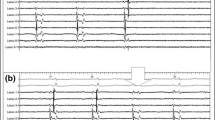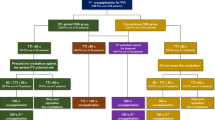Abstract
Background: Electrical isolation of pulmonary veins (PV's) is crucial to achieve success in catheter ablation for trigger elimination in focal atrial fibrillation (AF). To guide ostial PV radiofrequency (RF) delivery, it is necessary to identify the electrical breakthrough (EBT) between PV and left atrium. For this purpose, coronary sinus (CS) fixed rate pacing is commonly used. This study evaluated, whether CS extrastimulus pacing is superior in identifying the EBT area as compared to fixed rate pacing.
Methods: In 9 patients (51 ± 10 years) undergoing a left sided electrophysiological study for AF ablation, 25 PV's (10 right and 15 left-sided PV's) were mapped using a 4 French fixed-wire catheter with eight 6 mm coiled Platinum electrodes in a distal looped configuration (Revelation Helix, Cardima Inc.). For mapping and ablation the electrode loop was positioned in the PV ostium rectangular to the longitudinal PV axis. EBT area was identified as those electrodes indicating the earliest PV signals during CS pacing. We measured number of EBT electrodes and time between EBT and the latest activated bipoles at the electrode loop during fixed rate and extrastimulus pacing. The reduction of two or more EBT electrodes was defined as a significant benefit in EBT identification.
Results: In 22 of 25 PV's mapped PV potentials could be observed. Performing fixed rate pacing the EBT area was identified in a mean of 4.2 ± 1 electrodes, whereas using extrastimulus pacing, EBT area could be significantly reduced to 2.3 ± 0.8 electrodes. The time between EBT and latest electrode activated increased from 14 ± 7 ms to 22 ± 10 ms indicating an intrapulmonary conduction delay during extrastimulus pacing. In 13 of 22 PV's mapped (59%), extrastimulus pacing was beneficial in the identification of the EBT, as the primary target for RF delivery.
Conclusions: CS extrastimulus pacing induces intra-PV decremental conduction properties allowing one to identify a more localised and smaller EBT area as the primary target for RF delivery. Performing PV ablation to treat focal AF, extrastimulus maneouvers allow to unmask the “true” EBT and thus may help to limit intrapulmonary RF delivery.
Similar content being viewed by others
References
Haissaguerre M, Jais P, Shah D, Takahashi A, Hocini M, Quiniou G, Garrigue S, et al. Spontaneous Initiation of atrial fibrillation by ectopic beats originating in the pulmonary veins. N Engl J Med 1998;339:659–666.
Haissaguerre M, Shah D, Jais P, Hocini M, Yamane T, Deisenhofer I, Chauvin M, et al. Electrophysiological breakthroughs from the left atrium to the pulmonary veins. Circulation 2000;102:2463–2465.
Yu WC, Hsu TL, Tai CT, Tsai CF, Hsieh MH, Lin WS, Lin YK, et al. Acquired pulmonary vein stenosis after radiofrequency catheter ablation of paroxysmal atrial fibrillation. J Cardiovasc Electrophysiol 2001;12:887–892.
Hocini M, Shah DC, Jais P, Haissaguerre M, Peng JT, Yamane T, Deisenhofer I, et al. Concealed left pulmonary vein potentials unmasked by left atrial stimulation. PACE 2000;23:1832–1835.
Lewalter T, Burhardt D, Bielik H, Schrickel J, Yang A, Shlevkov N, Schimpf R, Schwab JO, Lüderitz B. Circumferential pulmonary vein mapping and ablation in focal atrial fibrillation: Single catheter technique. J Interv Card Electrophysiol 2002;7:165–170.
Lewalter T, Lüderitz B. Circumferential pulmonary vein mapping and ablation in focal atrial fibrillation. In: Ovsyshcher IE, ed. New Developments in Cardiac Pacing and Electrophysiology. New York: Futura Publishing, 2002:71–77.
Author information
Authors and Affiliations
Corresponding author
Rights and permissions
About this article
Cite this article
Lewalter, T., Burkhardt, D., Bielik, H. et al. Decremental Pulmonary Venous Pulse Propagation: Impact for Catheter Ablation in Focal Atrial Fibrillation. J Interv Card Electrophysiol 9, 269–273 (2003). https://doi.org/10.1023/A:1026248827908
Issue Date:
DOI: https://doi.org/10.1023/A:1026248827908




